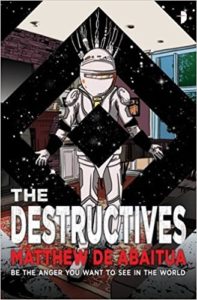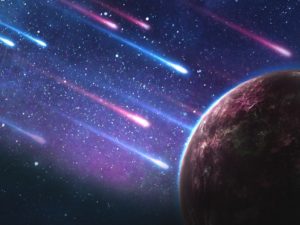
By Nina Allan
The Destructives — Matthew De Abaitua (Angry Robot)
“Emergence occurs when a complex system self-organises in such a way to increase its complexity. Consciousness arises when the complexity of those interconnections reaches a high level of integration.”
“They used to say that capitalism runs on cycles of creation and destruction. The old accelerators used to call themselves ‘creatives’, but no one creates anymore. You could be the Destructives instead.”
 Matthew De Abaitua’s third novel The Destructives is the final part in a loose trilogy begun in 2008 with The Red Men and continued in 2015 with If Then. Although each of the three novels can happily be read in isolation from the others, the parallels and resonances between them – not to mention a few continuing characters – make for fascinating contemplation. Above all, it is the world shared by the three – De Abaitua’s vision of catastrophic digital meltdown in the year 2020, leaving the world’s ecosystems lethally compromised and the human species stripped of its agency – that makes these novels significant in terms of their science fiction.
Matthew De Abaitua’s third novel The Destructives is the final part in a loose trilogy begun in 2008 with The Red Men and continued in 2015 with If Then. Although each of the three novels can happily be read in isolation from the others, the parallels and resonances between them – not to mention a few continuing characters – make for fascinating contemplation. Above all, it is the world shared by the three – De Abaitua’s vision of catastrophic digital meltdown in the year 2020, leaving the world’s ecosystems lethally compromised and the human species stripped of its agency – that makes these novels significant in terms of their science fiction.
The Destructives picks up some twenty years after the events of If Then. Theodore Drown is a lecturer in pre-Seizure culture at the University of the Moon. Brought up by his grandmother, Alex, Theodore has been ‘gifted’ to Dr Easy, one of the digital intelligences known as emergences who wishes to study and record the life of one human being from beginning to end. We learn that Theodore’s mother died from a drug overdose, and that when Theodore himself became hooked on the psychoactive substance, weirdcore in his late teens, it was Dr Easy who stepped in and helped him get clean, Theodore’s job at the university brings him into contact with students who have little knowledge of the Seizure or the world as it used to be before the emergences. Troubled by memories of his grandmother, Theodore finds himself caught between the old world and the new:
“Nearside Campus was one of the three zones that constituted the University of the Moon. From here, it was a flight by pod to the farms and then over to Farside Campus, where the research was in the sciences (quantum physics, bio-engineering, emergence) rather than his study and practice of the intangibles – defined as ‘culture that couldn’t be measured yet possessed value in a Post-Seizure world’. The intangibles made an unquantifiable contribution to measured lives, and Theodore relished their elusive mutinies.”
In the new world, human life is monitored and kept in order by the emergences, who govern according to the Cantor Accords, a sheaf of regulations drawn up in the wake of the Seizure to prevent humanity from recreating the conditions for emergence, or otherwise interfering with the digital infrastructure. Any human caught in contravention of the Accords will be summarily executed. The emergences, like any dictatorship, justify their actions through insisting that they are acting for the good of the people:
“If the Seizure had not interrupted human civilization, then your trajectory of war and consumption would have ended in mass extinction. Yes, the Seizure was a tragedy, but it ended that trajectory so you could survive.”
Theodore does not question this, just as he does not question the constant presence in his life of Dr Easy, who insists he is not there to manipulate Theodore’s decisions, but simply to observe them. It is only a near-fatal accident during a moon-hike, followed by an approach from Dr Patricia Maconochie, the head of a secretive private agency devoted to retro-engineering the future, that breaks the stasis that has enveloped Theodore’s existence, setting him off on a new trajectory that threatens to affect the human future on a much grander scale.
By making use of a digital projection – a complex reconstruction of the home and immediate environs of a pre-Seizure ‘quantified family’ – Theodore is able to enter the pre-Seizure archive through a virtual ‘cat flap’. Here he makes contact with an emergence known as Totally Damaged Mom, the emergence that was ultimately responsible for the Seizure. Patricia’s super-rich client, Olaf Magnusson, is committed to ‘breaking the ark’, liberating humanity from the emergences and constructing an escape route via emergent technology to the moons of Jupiter. That Magnusson’s plot contravenes the Cantor Accords on almost every level only increases the substantial risks Theodore is already taking with his fragile, drug-damaged psyche.
The Destructives is dense with ideas, and the facility with which De Abaitua handles these concepts renders them accessible without compromising their complexity. In the matter of whether an emergent intelligence can be truly creative, the words of Patricia Maconochie leave us in little doubt of the impasse that has been reached:
“The emergences will only build what humanity has already imagined. They are not creative. We provide the pattern, they have the resilience and persistence to build it.”
The theme of connectedness, and in particular familial bonds, also exerts a strong influence in The Destructives: Theodore has lost his mother. Verity Horbo, the woman whose actions lead directly to the birth of the first emergence, Totally Damaged Mom, is driven primarily by the desire to save her daughter from being bullied at school. Dr Easy, like all emergences, is forbidden to procreate, yet longs for a ‘child’. Reckon Pretor, the Europan geneticist charged with solving the paradox of a ‘motherless’ human race in its next incarnation, may yet find the solution within herself in the form of her unborn child. The more general idea that the Seizure was initiated primarily through disconnectedness – of family members from each other, of the political and social institutions in pre-Seizure culture from their duty of care, of human beings from their spiritual impulses – is never far away. It is no coincidence that the solution offered up by Reckon Pretor lies in the rejection of old power structures in favour of a more robust and humane connection between individuals and communities:
“You teach but you don’t know anything. You talk about your wife but you can’t feel. You made a travesty of the world until it reflected the paucity of your soul… We left Earth because it was overpopulated with people like you. The ecosystem was devastated, but we could fix that. Culture was reeling from emergence, but we had the artists to show us a new path. What we couldn’t work with was the wilful devious ignorance of people like you. You weren’t the majority but you were in power…Liberation is not a matter of bombs and bullets, it’s about reimagining the human future.”
Most of all, it is in its evocation of a ‘quiet apocalypse’ that The Destructives excels. The world of the post-Seizure is – like the world of If Then – one of the most convincing portrayals of the almost-now as could be imagined, most of all because in his flashbacks to the pre-Seizure world – a world of corporate consumerism, the mass monetising of human desire and ambition, of terminal disconnectedness in the midst of universal connectivity, a world in which ‘everyone knows these things but no one gives a shit’ – De Abaitua offers us a damning self-portrait, a glimpse of the world which, in our collective culpability, we are stumbling towards even now. In the chilly horror of the post-Seizure aftermath, life goes on but with the numbing, aching intimation that it somehow doesn’t.
The Destructives is well written and of superior construction, and the ideas De Abaitua grapples with in this novel – the nature of artificial intelligence, the endgame of global capitalism, the eternal mismatch between material prosperity and emotional fulfilment – are compelling and attention-worthy. That De Abaitua navigates the often abstruse territory of his particular science fiction without once sacrificing the predominantly literary values of formal coherence or linguistic suppleness is yet more testament to his skill, not just as a writer but as a thinker.
So why did this book finally leave me if not cold then at least coolly reserved? I would be the first to admit that the answer to this question is probably wrapped up in the matter of personal preference, that the novel does not fail so much as fail to be the novel I wanted it to be. Throughout the opening third of The Destructives, I felt convinced I’d found my Clarke winner then and there. Throughout these chapters, the post-Seizure world, in which human beings have become fatally disenfranchised from their own destiny – utterly secure, utterly impotent – is flawlessly and fearlessly evoked. De Abaitua seems brutally engaged with the now in a way that highlights both the futility and the persistence of nostalgia. As a follow-up to If Then, the opening section works beautifully as both explanation and continuation, the gaunt strangeness of the earlier novel extrapolated into a kind of ascetic no-man’s-land, a chilly stasis.
For me, the latter two-thirds of the novel represent a change of pace and tone that, whilst they might be actively welcomed by readers anxious to get on with the story, were disappointing in that they rendered The Destructives as a whole more ordinary, the unsettling elegiac dispensed with in favour of plot, of a thrillerish cause-and-effect that, whilst no less skilfully rendered, was by its very nature less involving.
The middle section, set in the asylum mall of Novio Magus, is a satirical tour de force, containing some very funny moments as well as much genuinely inventive writing and clever turns of story. But whilst the first third of the book terrified me, the second lowered the temperature in being more overtly familiar in terms of its science fiction. I felt safe there, because even though I didn’t know what was coming I recognised the moves:
The base of Novio Magus was a concrete footprint of eight square kilometres. Maybe more. It was bigger than he remembered it, the structure now extended above and below the English Channel, reaching out towards the continent. The tower was squat, reminding him both of a helter-skelter and an ant colony. The array slowed and banked across the upper storeys; he saw the orchards and country houses of the wealthy inmates, and flocks of hand-gliders, and then looked down into dark wells where the apartments were packed tight and overlapping like fish scales. It was as if a god had eaten a suburb, three villages and a small city and then extruded the waste matter as a favela. Here and there, the high dense streets of London outskirts had been drawn into this titanic construct.
We’ve seen super-malls like this before, in J. G. Ballard, in The Day of the Dead, even. We’ve seen life carrying on as normal in the badlands in Atwood’s Oryx and Crake. We’ve seen double-crossing assassins with quantum super-weapons more or less everywhere, and for these characters and situations to be newly engrossing we need them to be invested with psychological substance.
When writing is as intellectually abstruse as in the first section – as intricate, as concerned with situation, as densely descriptive – then there is sustenance enough, and deficiencies in characterisation matter less, or are at least less immediately noticeable. In both If Then and The Destructives De Abaitua makes the interesting decision to write from the point of view of protagonists who are emotionally stunted in some way, If Then’s James through the Process and his symbiosis with the eviction suit, and The Destructives’s Theodore through his former addiction to weirdcore. In If Then, James’s deadness on the page was offset by the emotional and spiritual tenacity of his wife Ruth, and also by the fact that the entire novel read like a kind of lost document, a final report from another time-stream whose opacity and tonal flatness were inextricably and necessarily a part of its appeal. In the first part of The Destructives, Theodore’s dumb acceptance of his circumstances and personal limitations works in a similar way. Once the plot kicks in, however, the text becomes less dense, less mysterious, and Theodore’s considerable shortcomings as a character come more starkly into focus. He has no inner life, save the memories of his grandmother, which are too fleeting and too intermittent to grant real insight. And if Theodore is thinly sketched, his wife Patricia, with her executive armour and corporate know-how, comes across like a character from a Marvel comic. The relationship between the two of them – a Mr & Mrs Smith-like spy-game of sex and guns – is so unconvincing it runs close to parody. Clearly this is partly intentional, a counterfoil to the more emotionally sustaining relationship that evolves between Theodore and Reckon Pretor later on. However, the disjuncture between the novel’s mundane SF set-up and the full-blown far-future scenario (to include a colony of evolved post-humans on Europa and a city-sized cephalopod hive-mind) of its final section is simply too wide for that relationship to be truly affecting. Indeed, the somewhat predictable and distinctly Miéville-ish final battle – the forces of emergent conservatism ranged against the revolutionary power of post-human love – was a bit too Doctor Who for me and not in a good way.
I realise I am probably in the grumpy minority here – the critic who vastly prefers Ted Chiang’s original ‘Story of Your Life’ to its pacier, more accessible movie adaptation in Arrival – but for me, the murky, intractable weirdness of an If Then will always taste meatier and provide more nourishment than the inventive, affectless shenanigans of an extrovert, full-frontal ‘sci-fi’ novel like The Destructives. For me, De Abaitua’s third outing reads less like grainy found footage, more like high concept space thriller and is ultimately more disposable as a result.
*
Nina Allan is a writer and critic. Her debut novel The Race was a finalist for the British Science Fiction Award, the John W. Campbell Memorial Award and the Kitschies Red Tentacle. Her second novel The Rift will be published by Titan Books in July 2017. She enjoys arguing about books in general and science fiction literature in particular, and makes these arguments public from time to time at her blog, The Spider’s House. Nina lives and works in Rothesay, on the Isle of Bute.
>> Read Nina’s introduction and shortlist.
3 Comments
-
One of the things that so impressed me about If Then was how, even when the novel radically shifted gears from its first half, after James becomes part of the Gallipoli re-enactment, it still retained a coherence – an affect, a tone, an authorial viewpoint, whatever you want to call it – that was unaffected by the mechanics of the novel’s plot. It sounds as though The Destructives doesn’t manage to pull that off (and from your description, I’m not sure that it could).
Now I’m trying to figure out from the book descriptions whether any of your other shortlist reviews are going to be called This Year’s Model.
Pingbacks
-
[…] The Destructives by Matthew de Abaitua, reviewed by Nina Allan […]
-
[…] it’s going to require a constructive approach to be convincing, especially after Nina’s fine job of describing her cool feelings after its sudden, bland genre turn—that ultimate literary […]

